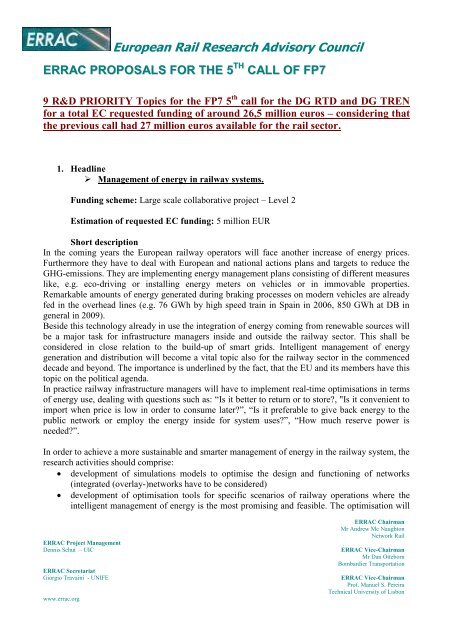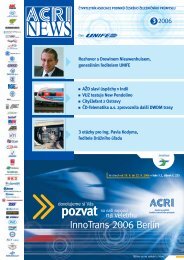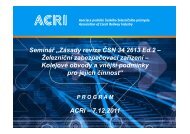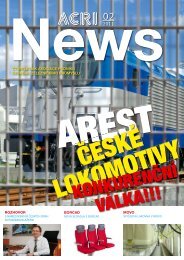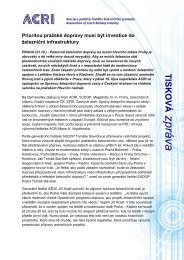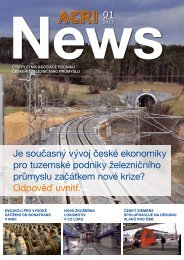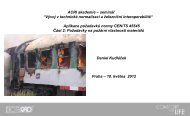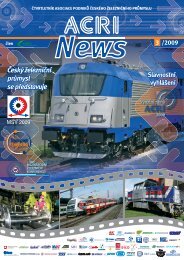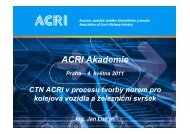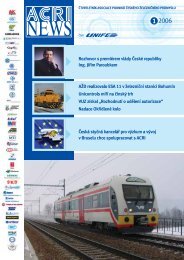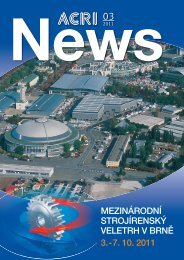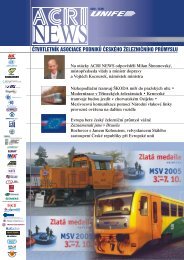ERRAC PROPOSALS FOR THE 3RD CALL OF FP7 - ACRI
ERRAC PROPOSALS FOR THE 3RD CALL OF FP7 - ACRI
ERRAC PROPOSALS FOR THE 3RD CALL OF FP7 - ACRI
Create successful ePaper yourself
Turn your PDF publications into a flip-book with our unique Google optimized e-Paper software.
European Rail Research Advisory Council<strong>ERRAC</strong> <strong>PROPOSALS</strong> <strong>FOR</strong> <strong>THE</strong> 5 TH <strong>CALL</strong> <strong>OF</strong> <strong>FP7</strong>9 R&D PRIORITY Topics for the <strong>FP7</strong> 5 th call for the DG RTD and DG TRENfor a total EC requested funding of around 26,5 million euros – considering thatthe previous call had 27 million euros available for the rail sector.1. Headline‣ Management of energy in railway systems.Funding scheme: Large scale collaborative project – Level 2Estimation of requested EC funding: 5 million EURShort descriptionIn the coming years the European railway operators will face another increase of energy prices.Furthermore they have to deal with European and national actions plans and targets to reduce theGHG-emissions. They are implementing energy management plans consisting of different measureslike, e.g. eco-driving or installing energy meters on vehicles or in immovable properties.Remarkable amounts of energy generated during braking processes on modern vehicles are alreadyfed in the overhead lines (e.g. 76 GWh by high speed train in Spain in 2006, 850 GWh at DB ingeneral in 2009).Beside this technology already in use the integration of energy coming from renewable sources willbe a major task for infrastructure managers inside and outside the railway sector. This shall beconsidered in close relation to the build-up of smart grids. Intelligent management of energygeneration and distribution will become a vital topic also for the railway sector in the commenceddecade and beyond. The importance is underlined by the fact, that the EU and its members have thistopic on the political agenda.In practice railway infrastructure managers will have to implement real-time optimisations in termsof energy use, dealing with questions such as: “Is it better to return or to store?, "Is it convenient toimport when price is low in order to consume later?”, “Is it preferable to give back energy to thepublic network or employ the energy inside for system uses?”, “How much reserve power isneeded?”.In order to achieve a more sustainable and smarter management of energy in the railway system, theresearch activities should comprise: development of simulations models to optimise the design and functioning of networks(integrated (overlay-)networks have to be considered) development of optimisation tools for specific scenarios of railway operations where theintelligent management of energy is the most promising and feasible. The optimisation will<strong>ERRAC</strong> Project ManagementDennis Schut – UIC<strong>ERRAC</strong> SecretariatGiorgio Travaini - UNIFEwww.errac.org<strong>ERRAC</strong> ChairmanMr Andrew Mc NaughtonNetwork Rail<strong>ERRAC</strong> Vice-ChairmanMr Dan OttebornBombardier Transportation<strong>ERRAC</strong> Vice-ChairmanProf. Manuel S. PereiraTechnical University of Lisbon
European Rail Research Advisory Councilconsider storage, buffering of energy in the infrastructure versus energy storage on board ofthe rolling stock. The economic and contractual price of energy will be important parametersto be considered.paving the way for systematization of the design of the network and electrical systems(including all relevant parts of the railway system) in order to obtain the best possible resultin energy terms with the available resourcesimplementation as far as necessary in real railway operations scenarios in order todemonstrate benefits of such improved management.2. Headline‣ Tools and conditions for an attractive, efficient and competitive wagon loadtraffic and its interaction with road or combined transports.Funding scheme: Small/medium scale collaborative project – Level 1Estimation of requested EC funding: 1 million EURShort descriptionSingle wagonload still represents a large share of the rail freight market, approximately 50 %. Thecompetition from road transport is severe; this is partly because the overall transport system isplanned for road usage. The density of the industrial web also makes wagonload more or lesscompetitive compared to combined transport. A dense industrial web (like in freight villages) isindeed more favourable to wagonload. There is a need to identify which industrial topographysupports wagonload on the one hand and combined transport on the other hand (and road-only) inorder to allow for a better industrial planning in the future.More generally, wagonload suffers from an unfair cost burden compared to road and combinedtransport, especially in the way certain costs are covered , not only infrastructure and external costs,but also other costs which are less under the spotlight (like those related to staff training, securityand safety, loading, marshalling, etc). In order to help politicians create a true level-playing fieldbetween modes and avoid cannibalisation of wagonload by trucks (and even by combinedtransport), it is essential to identify all these other “hidden” costs.The following should be addressed:• How can combined transport and wagonload each find their respective “rightful” place inthe freight transport landscape? What are the levers of each one? How does the density andorganisation of the industrial web favour one or the other? Which industrial topography and<strong>ERRAC</strong> Project ManagementDennis Schut – UIC<strong>ERRAC</strong> SecretariatGiorgio Travaini - UNIFEwww.errac.org<strong>ERRAC</strong> ChairmanMr Andrew Mc NaughtonNetwork Rail<strong>ERRAC</strong> Vice-ChairmanMr Dan OttebornBombardier Transportation<strong>ERRAC</strong> Vice-ChairmanProf. Manuel S. PereiraTechnical University of Lisbon
European Rail Research Advisory Councilorganisation best supports wagon load traffic? What density of the industrial web is requiredto make the last mile distribution more attractive by rail than by road?• Analysis of the problem of the differences in cost recovery within each production system(wagonload, combined transport and trucks), i.e.: main infrastructure costs, costs of mastmile connections, external costs, staff training, security (police), safety, loading,marshalling, etc.• Means to cope with the dismantlement of the secondary network, necessary to SWGbusiness.• How to utilize the high loading efficiency of wagon load traffic; by optimal routing, feederservices, etc.• The social dialogue: how to get acceptance for wagons in urban areas, how to get a planningwillingness to support wagonload traffic• Adoption and implementation of relevant information models to support punctuality,reliability and flexibility.Expected impact:An increase in the wagonload traffic by addressing the relevant hurdles, and, in a competitive way,support to the business initiatives. Help wagonload get its rightful place in the transport landscape,next to trucks and combined transport. Specification of readily useable solutions to the problematicsituation of wagonload, e.g. in respect of first/last mile connection costs and differences in costrecovery (main infrastructure, training, security, safety, loading, marshalling, external costs, etc.).Development of the advantages of wagon loads, new keys to customer satisfaction withincompetitiveness, services, usability and reliability. Definition of the need for new Marshalling Yardconcepts for efficient handling of (single) wagon loads and/or automatic/automated bundling ofwagons or a shunting-less Marshalling Yards.3. Headline‣ Territory and Rail towards 2050.<strong>ERRAC</strong> Project ManagementDennis Schut – UIC<strong>ERRAC</strong> SecretariatGiorgio Travaini - UNIFEwww.errac.orgFunding scheme: Small/medium scale collaborative project – Level 1Estimation of requested EC funding: 1 million EUR.Short descriptionToday‟s society is planned taking road as a basis for the transport system. Studies have shown thatthis planning is a ½ century process, if this basic structure is to be altered. Spatial planning, urbanplanning, housing, industrial, cohesion/development, etc. politicies are the “customers” of transportpolicies and ultimately define the “playing field” for the transport system. Local, regional, nationaland European authorities must therefore be given new “DECISION-MAKING TOOLS” to define<strong>ERRAC</strong> ChairmanMr Andrew Mc NaughtonNetwork Rail<strong>ERRAC</strong> Vice-ChairmanMr Dan OttebornBombardier Transportation<strong>ERRAC</strong> Vice-ChairmanProf. Manuel S. PereiraTechnical University of Lisbon
European Rail Research Advisory Counciltheir spatial planning, urban, housing, industrial, development/cohesion, etc. policies taking thetransport and environmental constraints into account “ex-ante”, rather than considering transportpolicy as an adjustment variable “ex-post”. This may have implications in how cities are built,industrial areas are shaped, industrial processes are re-organised, packagings are designed, etc.The following should be addressed:• A society planned for rail traffic (in co-modality with road traffic) rather than for road only.• The medium and long term planning for such a society, notably in the field of spatial planning,urban planning, housing, industrial, development/cohesion, etc. policies (and their interaction withthe transport policy). In this context, a number of concepts will have to be re-visited: “Just-in-time” versus “stock management combined with mass transport” “Vertical housing” versus “horizontal housing”: Planning of urban areas to avoid thedominated by road traffic, to make the cities more compact, with more intensiveurban qualities and better conditions for public transport as well as biking andwalking. Transportation tools for decreased urban land use and savings of the openlandscape. “Produce local – consume local”, based on “technology transfers” (licensing) ratherthan the actual movement of goods. “Freight villages” versus “spread industrial web” “Packaging” (reduce heavy and bulky packaging) Etc.• How to, in a 30+ year horizon, shape an overall public transportation system from local andregional transportation to inter-regional and international transportation, based on modern railtransport – from light rail and tram to long-distance high-speed day and night trains?• A long-term vision for a pan-European high-speed rail network, also connecting Europe with Asiaand Africa.Expected impact:Improve the key long term overall factors making rail systems more useable and attractive to moreusers, by the shaping of a more rail transport friendly society and prioritise the planning of “policiesother than transport” to overcome the hurdles for rail.To develop decision-making tools for local, regional, national and European authorities on how toshape other policies than transport policies like industrial, spatial planning, urban planning,housing, development/cohesion, etc. in order to take into account transport as a constraint and nomore as an adjustment variable. It will also give planners and decision makers methods how tointegrate transportation system and urban/industrial planning in a holistic concept for sustainableurban/industrial development including respect of landscape and environmental values.<strong>ERRAC</strong> Project ManagementDennis Schut – UIC<strong>ERRAC</strong> SecretariatGiorgio Travaini - UNIFEwww.errac.org<strong>ERRAC</strong> ChairmanMr Andrew Mc NaughtonNetwork Rail<strong>ERRAC</strong> Vice-ChairmanMr Dan OttebornBombardier Transportation<strong>ERRAC</strong> Vice-ChairmanProf. Manuel S. PereiraTechnical University of Lisbon
European Rail Research Advisory Council4. Headline‣ Improving the performance of urban, suburban and regional rail networks andminimising service disruption in case of incidents on the urban rail system.Funding scheme: small/medium scale collaborative project – Level 2Estimation of requested EC funding: 1,5 million EUR.Short descriptionThe objective is to minimize the negative impact of rail service disruption due to incidents on thecustomers directly affected or potentially affected by the service disruption. It is also to proposesatisfactory alternative transport solutions for customers during the rail service disruption andsolutions speeding up the recovery of normal operations conditions for the whole publictransportation system.This will consist in three main activities:• To identify the various categories of rail operations incidents affecting the customer dueto service disruption• To benchmark the overall public transport system management solutions proposed incase of rail service disruption• To propose guidelines and recommendations to propose alternatives solutions during therail service disruption and recover a quickly as possible normal operations conditions forthe whole public transportation system5. Headline‣ Railway assets preventing monitoring of severe natural events.Funding scheme: small/medium scale collaborative project – Level 2Estimation of requested EC funding: 3 million EUR.Short descriptionIt is generally acknowledged that climatic conditions are changing. Natural causes are threateningthe safe operation of railways (flood, strong winds, excess of water in the soils, unusual heights ofsnow, extremely low temperatures, as well as potentially volcano ashes, earthquakes, tsunamis, etc).Generally railways are prepared to environmental conditions experienced in the past century<strong>ERRAC</strong> Project ManagementDennis Schut – UIC<strong>ERRAC</strong> SecretariatGiorgio Travaini - UNIFEwww.errac.org<strong>ERRAC</strong> ChairmanMr Andrew Mc NaughtonNetwork Rail<strong>ERRAC</strong> Vice-ChairmanMr Dan OttebornBombardier Transportation<strong>ERRAC</strong> Vice-ChairmanProf. Manuel S. PereiraTechnical University of Lisbon
European Rail Research Advisory CouncilA research programme is needed to increase - through early infrastructure assets monitoring followup- availability, capacity and safety, of railways in extreme natural events situations. The intent isto keep such events under due control rather then to mitigate the disruption they do infer once theyoccur.The following activities will be covered:• Analysis of the most severe environmental conditions the various regions of Europe aresubjected to (e.g. fires and floods in the south, ice and heavy snow in the north, strongwinds, volcano ashes, earthquakes and tsunamis in respective sensible areas, etc.)• Development and integration of technologies allowing the earliest detection as possible ofinfrastructure degradation due to forthcoming natural cataclysms.• Selected technologies shall be convenient to the early detection of natural events potentiallyaffecting the whole railway operating components that is, track, overhead line and trainclearance• Selected infrastructure monitoring technologies shall be intrinsically associated tolocalization systems able to allow the most prompt identification as possible of the railwayassets requiring urgent preventing maintenance (e.g. Km on the line)• Field tests demonstrationsThe research results shall allow increasing of:• Availability and capacity of European Railways for citizens using it for personal andprofessional reasons, and, for the freight volume moving through it;• Safety and efficiency of rail operations: the rail network is built on a wide variety of terrainsand is subject to different geo-technical conditions, the interaction of these factors togetherwith climatic and seismic forcing, is a source of several geo-technical failures that has animpact safety.The proposed research shall enhance innovation through the establishment, in railway regularoperations, of measuring systems that are cost effective and capable to detect forthcoming severenatural events, timely enough to be equally efficiently managed.<strong>ERRAC</strong> Project ManagementDennis Schut – UIC<strong>ERRAC</strong> SecretariatGiorgio Travaini - UNIFEwww.errac.org<strong>ERRAC</strong> ChairmanMr Andrew Mc NaughtonNetwork Rail<strong>ERRAC</strong> Vice-ChairmanMr Dan OttebornBombardier Transportation<strong>ERRAC</strong> Vice-ChairmanProf. Manuel S. PereiraTechnical University of Lisbon
European Rail Research Advisory Council6. Headline‣ Rail System Interoperability (regulatory and non-legislative interoperabilitybased on technological innovations).Funding scheme: Small/medium scale collaborative project – Level 1Estimation of requested EC funding: 6 millions EUR for the different proposals that willcome out of this small/medium scale topic level 1.Short descriptionTechnologies and innovative train concepts for both passengers and freight transport characterizedby interoperability and cross-operation between different rail networks.The proposed solutions will be based on advanced mechatronic systems, on-board electronics,information and communication systems and services. Research results will contribute tostandardisation at two main levels: 1) In the regulated domain, related to Technical Specificationsfor Interoperability (TSIs) and the need for further standardised specification may appear with theTSI geographical scope extension; 2) In the non regulated domain, innovative solutions forinteroperability and standardised interfacing between mostly proprietary solutions. These measuresare a necessary tool for strengthening the competitiveness of the rail sector.Proposals will cover (but not necessarily be limited to) one or more of the following subjects:Preventive axle bearing condition monitoring: Identify indicators (acoustic, vibration etc.) for early stage development of axle bearingsdefects Development of prototypes of diagnostic systems for preventive axle bearing and trackcondition monitoring, both on-board and track side, focussing on high speed traffic Analyse the economic optimum distribution from a railway system point of view, hence ofboth on-board and track side solutions considering the relation between monitoring intervalsand measurement precision Demonstrate technical feasibility of the technical solutionsBraking system independent of adhesion conditions: Eddy current brake Improve understanding of the interaction of the eddy current brake with the track andtrackside signalling equipment Identify critical thermal, mechanic and electromagnetic parameters and its related vehicleand trackside compatibility limits Develop design, engineering and operational guidelines for new eddy current brakes andnew trackside signalling equipment<strong>ERRAC</strong> Project ManagementDennis Schut – UIC<strong>ERRAC</strong> SecretariatGiorgio Travaini - UNIFEwww.errac.org<strong>ERRAC</strong> ChairmanMr Andrew Mc NaughtonNetwork Rail<strong>ERRAC</strong> Vice-ChairmanMr Dan OttebornBombardier Transportation<strong>ERRAC</strong> Vice-ChairmanProf. Manuel S. PereiraTechnical University of Lisbon
European Rail Research Advisory CouncilCommon data protocols for end applications or end devices Review existing application profiles, operational requirements and use cases and analyzetheir potential for migration towards harmonized functional interface specifications (FIS) fortrue interoperability of end devices to avoid obsolescence problems Develop FIS for end applications like brake control, door control or propulsion control etc. validate FIS in a simulation environment (laboratory tests) Disseminate the FIS for further processing in industry specifications7. Headline‣ Standardisation of conventional signalling systems to accelerate a EuropeanETCS rollout.Funding scheme: Large scale collaborative project – Level 2Estimation of requested EC funding: 5 million EUR..Short descriptionThe aim of the research will be to develop formal specifications and test cases for conventionalsignalling systems in line with the relevant European norms to facilitate the introduction of ETCSsystems. The project will build on experiences gained within ETCS projects and the results ofexisting research work where the methodical basis as well as functional requirements has beenestablished. It will lead to standardisation processes involving national and Europeanstandardisation bodies as well as national safety authorities.Activities will include:1. The formal definition of static and dynamic requirements of signalling systems withagreement between railways and signalling suppliers on a common allocation of functions tosub-systems and/or to adjacent systems such as traffic management systems or radio blockcentres.2. Development of test cases for conventional signalling systems which are in line with the testcases for the ETCS equipment and a concept for building a test centre to support Europeanlegislation with respect to e.g. EG 352/2009, EG/57/2008, etc.3. Implementation of standard interfaces in a real demonstration project to validate thespecification.<strong>ERRAC</strong> Project ManagementDennis Schut – UIC<strong>ERRAC</strong> SecretariatGiorgio Travaini - UNIFEwww.errac.org<strong>ERRAC</strong> ChairmanMr Andrew Mc NaughtonNetwork Rail<strong>ERRAC</strong> Vice-ChairmanMr Dan OttebornBombardier Transportation<strong>ERRAC</strong> Vice-ChairmanProf. Manuel S. PereiraTechnical University of Lisbon
European Rail Research Advisory CouncilSpecific attention will be given to an optimal support to accelerate the rollout of ECTS and theincorporation of inputs from European research into satellite based positioning.Close collaboration of infrastructure managers, railway undertakings and systems suppliers will beestablished including the dialogue with railway organisations having specific requirements, in orderto reduce any non-standard conditions to a minimum.The research will lead to standardised and cost effective European signalling systems designed tofacilitate the introduction of ETCS particularly on pan-European corridors. Based on a cost/benefitanalysis, a number of interfaces between interlocking sub-systems or adjacent systems will bestandardised. The project will contribute to drive the harmonisation of testing, validation andverification of requirements in the railway signalling area to achieve a harmonised European safetylevel.8. Headline‣ Next generation tools for optimised infrastructure asset management.<strong>ERRAC</strong> Project ManagementDennis Schut – UIC<strong>ERRAC</strong> SecretariatGiorgio Travaini - UNIFEwww.errac.orgFunding scheme: Small/medium scale collaborative project – Level 2Estimation of requested EC funding: 3 million EUR.Short descriptionIn recent years infrastructure managers in the oil, electricity and water industries have improvedtheir performance through the development of asset management support tools. Strategic tools maybe low resolution using generic data, but high resolution tools are required to accurately model aspecific location in order to optimise maintenance and renewal decisions.Railway infrastructure is subjected to more variables than most utility companies, and risk, cost,availability and performance are important parameters under different vehicle, traffic density andenvironmental conditions.This diversity of operating conditions requires the most advanced tools to create the necessaryintegrity for high resolution models to support maintenance decisions with a value of billions of €per annum.The next generation tools will be developed by investigatingo Application of fuzzy analysis techniqueso Linkage to tools modelling vehicle dynamic behaviour, traffic density, track quality, trackstiffness and past maintenance history<strong>ERRAC</strong> ChairmanMr Andrew Mc NaughtonNetwork Rail<strong>ERRAC</strong> Vice-ChairmanMr Dan OttebornBombardier Transportation<strong>ERRAC</strong> Vice-ChairmanProf. Manuel S. PereiraTechnical University of Lisbon
European Rail Research Advisory Councilo Case studies for selected sitesThe preservation and future development of the tools and data developed in this project will beachieved through the formation of an asset management club managed by the project participantsNote:This project differs from the topic of the 4 th call [SST.2011.5.2-6] in many ways, but specifically inthat all categories of railway assets are included and the highest possible resolution necessary foroptimised solutions will be achieved through the linking of models9. Headline‣ The urban rail stations of tomorrow: attractive rail services, profitableoperation, multimodal integration and land-use structuring effect.<strong>ERRAC</strong> Project ManagementDennis Schut – UIC<strong>ERRAC</strong> SecretariatGiorgio Travaini - UNIFEwww.errac.orgFunding scheme: Small/medium scale collaborative project – Level 2Estimation of requested EC funding: 1 million EUR.Short descriptionRecommendations for the design and operation of the urban and regional rail stations of the future(new ones or upgraded) will be established. They shall address the various categories of railstations, depending upon their function and location within the city. The design of the stations shallcover the internal characteristics of the station as well as its relationship with the surrounding urbanfabric („structuring effect‟ of the rail station). The operation shall consider the services to be offeredas part of public service contracts.The aim is to produce guidelines for a more efficient functional and layout design and for aprofitable operation of new or upgraded rail stations. These stations would be able not only to betterserve the needs of current customers but also to attract new passengers on rail and to take advantageof the location of the station and of the rail system to offer new services and improve theeffectiveness of operation of the entire city public transport system. The factors that allow thefollowing will be analysed: to make the operations of rail stations more profitable and possibly operated under specificpublic service contracts to better sustain the city development both in the short term and in the long term thanks tothe choice of the location of a new station and to the organisation of the relationship with<strong>ERRAC</strong> ChairmanMr Andrew Mc NaughtonNetwork Rail<strong>ERRAC</strong> Vice-ChairmanMr Dan OttebornBombardier Transportation<strong>ERRAC</strong> Vice-ChairmanProf. Manuel S. PereiraTechnical University of Lisbon
European Rail Research Advisory Councilpotential connecting modes, including streamlining the urban, suburban and regional railinfrastructure for more efficient land use facilitating as well the densification of dwellingand/or activities around the stations.<strong>ERRAC</strong> Project ManagementDennis Schut – UIC<strong>ERRAC</strong> SecretariatGiorgio Travaini - UNIFEwww.errac.org<strong>ERRAC</strong> ChairmanMr Andrew Mc NaughtonNetwork Rail<strong>ERRAC</strong> Vice-ChairmanMr Dan OttebornBombardier Transportation<strong>ERRAC</strong> Vice-ChairmanProf. Manuel S. PereiraTechnical University of Lisbon


